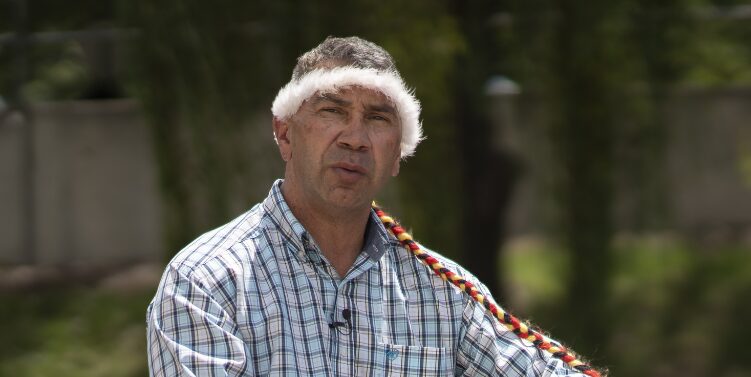Mother Earth loan – an agribusiness finance model that cares for Country

The Mother Earth loan is designed to support the purchase of freehold title farmlands by First Nations farmers to revive traditional practices. It’s based on similar modelling to HECS, where repayments are due when Mother Earth is ‘healthy and able to share’ and payments are paused or significantly reduced when ‘Mother is struggling and needs time to heal’. Paul Girrawah House, one of the founders of the Waluwin Foundation, explains how it can work, its benefits and the role philanthropy can play.
Waluwin mayiny – healthy people.
Waluwin ngurambang – healthy country.
Yuwindhu Paul Girrawah House, baladhu Ngambri-Kamberri Wiradyuri Gibirr. My name is Paul Girrawah House, I am a Ngambri-Kamberri, Wiradyuri man.
Yindyamarra bala Biyaami walumarra marramaldhaany umbe yukembruuk, yibay Maliyan. Respecting Biyaami, our creator and protector and key totems, the Crow and Eagle.
In the early 1800s, our ancestors first heard about whitefellas through their trading partners. They heard whitefellas wanted land, women and children. Our ancestors fled to the mountains. Many died of introduced diseases. Our men, women and children were shot on sight. Others were treated with untold brutality.
‘Lest we forget’.
I am a survivor and descendant of my old people.
I want to become a farmer again.
I want to return home to Country.
I want to bring back connection and provenance stories.
I want to create genuine intergenerational wealth for our children.
But I am currently excluded from borrowing money that will let me farm the way of my old people.
If I take out a whitefella loan, I am expected to farm like a whitefella. It’s on whitefella terms, with no connection to Country, no understanding of gandaywarra, the long grow.
The current whitefella loan demands a farmer to run half dead animals across dust trying to hold onto the farm.
This is financing that forces a farmer to despair, and worse.
This is financing that expects the Government to bail farmers out during drought or floods.
This is financing offered by people who don’t understand Country. People who’ve never really listened to blackfellas.
I have delivered hundreds of Welcome to Country ceremonies. Contained in the words of our Ancestors is the roadmap to financing a better way, financing a blackfella way for a land that blackfellas have looked after for over 60,000 years.
Finance that is wudhadhuray. Clever finance that has ears and listens to the Ancestors story.
Yet no one has ever invited me, or any other blackfellas, into the room to listen to these stories and talk finance.
For that I offer the Waluwin story.
Waluwin was created to show a new/old way for Indigenous nation-building, starting with re-establishing the Indigenous agrarian economy.
It’s an economy built on yindyamarra, an economy that respects Mother Earth.
An economy that operated for tens of thousands of years.
But for blackfellas that want to buy the farm freehold, they need a new approach that allows them to farm like a blackfella.
They need Ngama bangalnarranarra, a Mother Earth loan.
The Mother Earth loan is finance based on our ancient traditional knowledge of managing an unpredictable and varying climate.
A loan that allows Indigenous farmers to respect, and not hurt, Mother Earth.
A loan that cares for Country – for farming, for environment, for people.
A loan that repays when Mother is healthy and able to share.
A loan that rests when Mother is struggling and needs time to heal.
For most Australians to understand, it’s a loan that works a lot like HECS. You pay when Country is healthy and receive relief when Country is stressed.
Helping with the financial modelling, we have a team at the Australian National University leading the analysis. The graph below details the loan dynamics as a function of cumulative profit. It is based on a simple cattle operation with only a mild drought shock included in the early years of operation. The Red bars illustrate cumulative profit under a standard loan – constant repayment required no matter the prevailing drought conditions. Whereas the blue bars detail the operation under a Mother Earth loan, where repayments are only required when the operation is not in drought. (This is modelled as a “revenue contingent loan” based on the extensive works of Emeritus Professor Bruce Chapman).

The financial mathematics underpinning the Mother Earth loan has been around for years. What is new is that this knowledge has now been paired with 60,000 years of understanding. Indigenous people led the design approach for the loan, developing a way to finance a better way to farming in the face of an increasingly unpredictable climate.
It is a farm finance that can deliver Indigenous economic development and self-determination; improved soil health, biodiversity and animal welfare; reduce loan anxiety and bankruptcy. It’s also financing that doesn’t rely on government assistance for taxpayer-supported loan relief.
The Mother Earth loan is not only a way for blackfellas to buy freehold title land and farm the way of our Ancestors, but it’s a loan for all Australian farmers that want to respect Country.
The Mother Earth loan is a rare example Indigenous people’s contribution to the financial conversation in this country. It is a way for Indigenous people to regain the intergenerational wealth that was stolen.
The next step for the Mother Earth loan is to prove the concept on Country. For people to believe, they need to see blackfellas back farming their lands, repaying loans and building an Indigenous agrarian economy. Through a partnership with Indigenous farmers, philanthropy can play a pivotal intermediary role in catalysing action by underwriting any misalignment between the Mother Earth loan and standard agri-finance repayment schedules for the initial proof-of-concept projects. Demonstrating the value of embedding 60,000 years of knowledge in Australia’s financial system to both government and the banking sector will have far-reaching benefits for all Australians.
That is the Waluwin story.